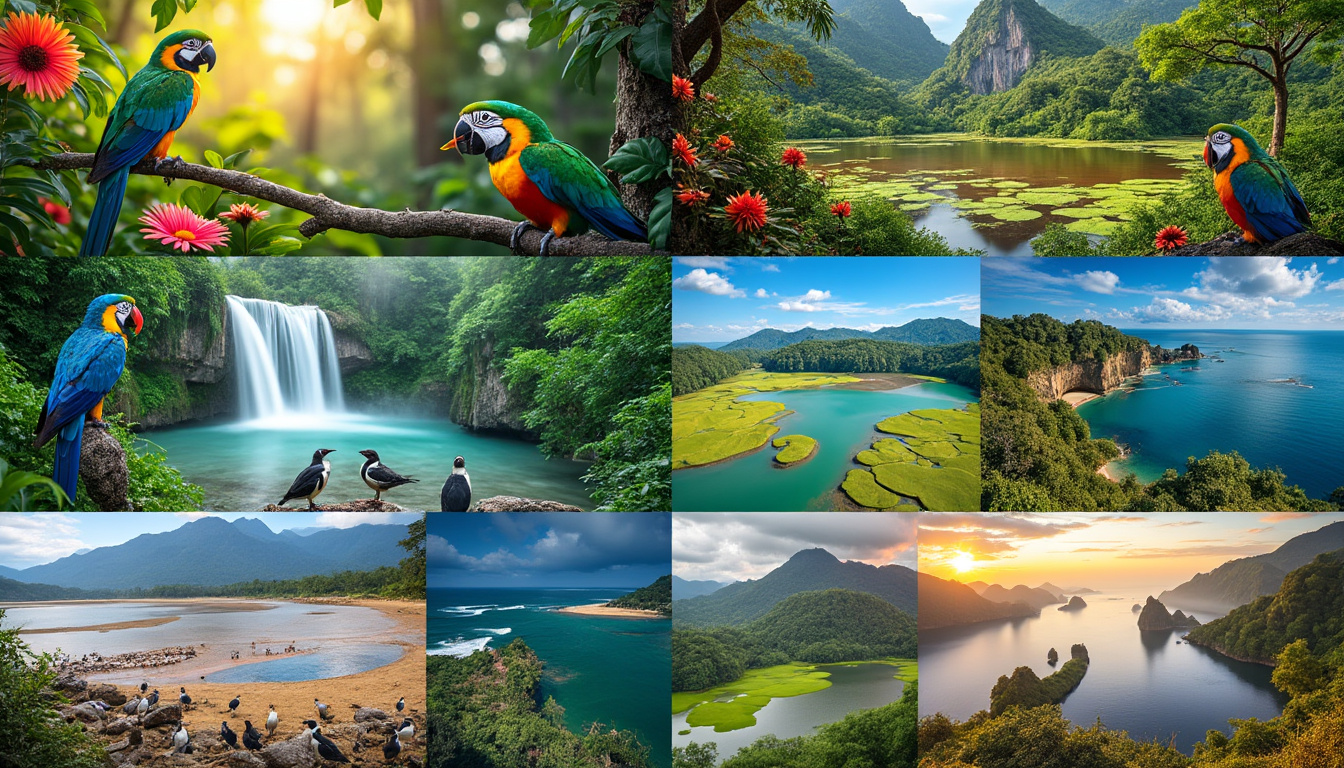The captivating world of birdwatching continues to grow in popularity among nature enthusiasts and travelers alike, offering an extraordinary fusion of adventure, tranquility, and discovery. In 2025, avid birdwatchers seek more than just fleeting glimpses; they yearn for immersive experiences in stunning environments where winged wonders reveal their vibrant hues and distinctive behaviors. This pursuit is fueled by advancements in optical technology from brands like Celestron, Swarovski Optik, and Zeiss, helping observers gain unparalleled views of rare and elusive species. From the dense tropical rainforests of Borneo to the sweeping savannahs of East Africa, these eight international hotspots stand out as premier destinations where biodiversity converges with spectacular landscapes, promising unforgettable birdwatching adventures.
Enthusiasts planning their next avian journey can now tap into extensive databases such as eBird and gain insights from the Cornell Lab of Ornithology, enhancing their ability to locate specific birds and seasons for ideal viewing. Meanwhile, the influence of leading nature-focused media like National Geographic continues to inspire a global audience, drawing attention to rare species and conservation efforts. Alongside the natural allure, technological advances in discreet audio equipment like Bose headphones allow birders to immerse themselves in the symphony of calls without disturbing the habitats they cherish.
Below, the exploration of these premier birdwatching destinations unfolds, rich with expert tips, wildlife highlights, and insightful details that help transform every trip into an unforgettable avian adventure.
Discover the Tropical Richness of Borneo’s Sabah Rainforests for World-Class Birdwatching
The Malaysian state of Sabah, nestled on the island of Borneo, is a treasure trove for birdwatchers seeking encounters with rare and exotic species. The region boasts lush rainforests, riverine ecosystems, and conservation areas that shelter a dazzling array of birds, making it one of the most thrilling avian destinations in Southeast Asia.
Key Birdwatching Locales: The Kinabatangan River is a hotspot for birdwatching, with its diverse habitats providing refuge to hornbills, pittas, and colorful broadbills. Floating down the river in a traditional boat offers an intimate experience, with chances of spotting the elusive Rhinoceros Hornbill, a symbol of Borneo’s forest heritage. Danum Valley Conservation Area, a pristine expanse of dipterocarp forest, invites visitors to explore dense trails where vocal and brilliantly plumed pittas, babblers, and flycatchers abound.
Birdwatchers who venture here are often rewarded with prime glimpses of several rare species endemic to Borneo, such as the Bulwer’s Pheasant and the spectacular Bornean Bristlehead. The area’s remarkable biodiversity is complemented by sightings of other wildlife, including orangutans and pygmy elephants, enriching the overall experience.
The peak birdwatching season coincides with the dry months from March to October, when forest activity peaks, and migratory species add to the region’s already impressive variety. For optimal visual encounters, binoculars and spotting scopes from brands like Vortex Optics and Zeiss are indispensable, allowing birders to appreciate the intricate details and behaviors of even the most skittish species.
- Top species to watch: Rhinoceros Hornbill, Blue-headed Pitta, Sultan’s Cuckoo-Dove, Bornean Bristlehead
- Recommended gear: Waterproof field guide, insect repellent, Celestron binoculars, lightweight waterproof clothing
- Best access points: Sukau, Bilit, and Danum Valley Field Centre
- Local tour providers: Specialized birding tours available with expert guides fluent in bird call identification
| Location | Main Bird Species | Best Viewing Season | Accessibility |
|---|---|---|---|
| Kinabatangan River | Rhinoceros Hornbill, Broadbill | March – October | Boat tours from Sukau |
| Danum Valley Conservation Area | Blue-headed Pitta, Bornean Bristlehead | March – October | Guided treks from Danum Valley Field Centre |
Combining Wildlife and Birding: The Complete Sabah Experience
Beyond birdwatching, Sabah offers a holistic wildlife encounter. Adventurers can explore unique ecosystems teeming with other fauna, making each trek a multidimensional discovery. Expert guides ensure that visitors adhere to ethical birdwatching practices, supporting local conservation efforts and minimizing impact.
Those preparing their kit may consult the latest insights from the Bird Watching Travel Guide, which recommends high-quality optics and quiet boots to approach sensitive bird habitats without disturbance. The technological strides made by companies such as Swarovski Optik enhance the ability to observe birds at greater distances with crystal-clear clarity, a crucial aspect when tracking rare species in dense canopies.
The Savannahs and Lakes of East Africa: Combining Birdwatching Adventures with Iconic Wildlife Safaris
East Africa remains an unmatched destination where birdwatching adventures intersect with classic wildlife safaris. The region’s vast savannahs and lakes are home to over 1,000 bird species, drawing birders passionate about encountering flamingos, eagles, and endemic species amid the backdrop of iconic African landscapes.
Featured Birding Sites: Lake Nakuru and Lake Naivasha, found in Kenya’s Great Rift Valley, are world-renowned for their spectacular flocks of flamingos. These lakes are also habitats for fish eagles, pelicans, and a vast array of waterbirds. Visitors often marvel as thousands of flamingos paint the shores vivid pink, offering irresistible photo opportunities. The Maasai Mara National Reserve, while famous for the Big Five, is also a prime spot for spotting raptors, hornbills, and the stunning lilac-breasted roller.
Birdwatching here can be seamlessly combined with the pursuit of seeing Africa’s most emblematic mammals, enriching the length of stay and diversity of experiences. Utilizing digital tools and resources from eBird helps travelers map out recent sightings and hotspots, ensuring optimal routes and timing.
- Popular bird species: Lesser Flamingo, African Fish Eagle, Lilac-breasted Roller, Secretarybird
- Recommended equipment: Zeiss spotting scopes, Celestron binoculars, Bose wireless headphones for silent call identification
- Ideal visiting months: June to October during the dry season
- Suggested activities: Day-long bird safaris, dawn viewing excursions, boat rides on Lake Naivasha
| Site | Notable Birds | Best Season | Additional Wildlife |
|---|---|---|---|
| Lake Nakuru | Lesser Flamingo, Pelicans | June – October | Rhinoceros, Buffalo |
| Maasai Mara | Lilac-breasted Roller, Secretarybird | June – October | Lions, Elephants |
| Lake Naivasha | African Fish Eagle, Kingfisher | June – October | Hippos, Otters |
Combining superb optics with immersive soundscapes provided by Bose technology allows birders to identify calls discreetly, increasing the chances of spotting elusive species. Conservation programs promoted through organizations linked to the East Africa Birdwatching scene also enhance eco-tourism sustainability, deepening the value of visits.
Exploring the Unique Avian Diversity of Costa Rica’s Tropical Birdwatching Paradises
Costa Rica remains one of the world’s most beloved destinations for birdwatching adventures, boasting over 900 species in a small but biologically rich territory. Its cloud forests, coastal wetlands, and volcanic highlands create ideal habitats for colorful and rare birds.
Top Destinations: Monteverde Cloud Forest Reserve stands out as a sanctuary for quetzals, hummingbirds, and toucans. Carara National Park, located near the Pacific coast, is celebrated for scarlet macaws and other vibrant parrots. The Osa Peninsula is another hot spot for endemic and tropical species, including the elusive Black-cheeked Ant-Tanager.
The accessibility of Costa Rica, alongside its strong commitment to conservation, has attracted ornithologists and tourists alike. Services supported by global organizations like the Cornell Lab of Ornithology facilitate community-driven bird counts contributing to global biodiversity databases.
- Essential species to spot: Resplendent Quetzal, Scarlet Macaw, Three-wattled Bellbird
- Gear recommendations: Lightweight Zeiss binoculars, digital camera with long lens, wildlife field guides
- Optimal season: December to April for dry, clear weather
- Local birding tours: Guided walks focusing on endemic species and migratory bird patterns
| Region | Bird Species Highlight | Best Visiting Months | Terrain Type |
|---|---|---|---|
| Monteverde Cloud Forest | Resplendent Quetzal, Hummingbirds | December – April | Cloud Forest |
| Carara National Park | Scarlet Macaw, Toucans | December – April | Rainforest |
| Osa Peninsula | Black-cheeked Ant-Tanager | Year-round | Coastal Lowland Jungle |
To best prepare for excursions, birdwatching enthusiasts can consult resources like Bird Watching Travel Guide and explore the latest models of optics by Swarovski Optik, praised for their precision and durability in tropical climates. Experienced guides use audio playback technology to entice shy species, maximizing encounters for even novice birdwatchers.
Immersive Birding Encounters in the Wetlands of Florida’s Everglades National Park
Florida’s Everglades National Park represents an otherworldly ecosystem celebrated not only for its alligators and manatees but as a premier birdwatching destination in North America. The park’s vast wetlands teem with avian diversity, making it a magnet for birdwatchers seeking species ranging from roseate spoonbills to rare marsh birds.
Bird Species Diversity: Home to over 300 bird species, the Everglades offers visitors spectacular sightings of wading birds, raptors, and seabirds. The unparalleled presence of the roseate spoonbill, with its striking pink plumage, provides one of the most iconic and photogenic opportunities in the park. Additionally, birders can find multiple heron and egret species cohabiting in the wetlands, creating dynamic scenes perfect for photographers and naturalists alike.
Birdwatchers are encouraged to utilize products such as Vortex Optics binoculars and spotting scopes for clarity when scanning the broad expanses of water and marsh. Complementing optics, modern noise-cancelling headphones by Bose facilitate identification of subtle bird calls amidst ambient wetland sounds.
- Species to look for: Roseate Spoonbill, Great Egret, Bald Eagle, Limpkin
- Visitor tips: Early morning visits enhance sighting success; wear waterproof boots and sun protection
- Ideal seasons: Winter months (December to March) when migratory birds are present
- Recommended access points: Anhinga Trail, Shark Valley, and Gulf Coast Visitor Center
| Trail | Key Birds | Best Viewing Time | Accessibility |
|---|---|---|---|
| Anhinga Trail | Roseate Spoonbill, Limpkin | Early morning | Wheelchair accessible |
| Shark Valley | Great Egret, Bald Eagle | Morning and late afternoon | Bike rentals available |
| Gulf Coast Visitor Center | Wading birds, Ospreys | All day | Boat tours accessible |
Educational programs run by institutions such as the Cornell Lab of Ornithology provide expert knowledge aiding in species identification and ethical viewing practices. Birdwatching groups often leverage apps like eBird to record sightings and share insights, fostering a collaborative birdwatching community.
Engaging with Birdwatching Culture and Community in the Everglades
Besides wildlife viewing, the Everglades nurtures a vibrant birdwatching culture supported by local organizations and eco-tourism operators. Events and guided tours encourage participation from families to seasoned birders. Modern optics companies such as Celestron often sponsor birding festivals here, blending technology demonstrations with nature exploration.
Unconventional Birdwatching Destinations: From Spain’s Deserts to Bahamas’ Coastal Regions
While traditional hotspots offer spectacular avian spectacles, remarkable diversity also thrives in less expected environments like the arid deserts of Spain and tropical coastal regions of the Bahamas. These locations broaden the birding horizon, enticing adventurous travelers keen to explore diverse habitats.
Birding in Spain’s Deserts: The semi-arid and desert landscapes of southern Spain provide encounters with uniquely adapted species such as the Dupont’s Lark and Black-bellied Sandgrouse. Regions like Tabernas Desert offer raw and vast landscapes that contrast beautifully with concentrated bird populations. Birdwatchers here often observe seasonal migrations and species that have adapted to harsh conditions.
Bahamas Coastal Birding: The Bahamas’ coastlines, mangroves, and barrier islands attract an array of seabirds, wading birds, and tropical migrants. Locations like the Exuma Cays National Park highlight the convergence of marine and avian ecosystems. Birdwatchers can spot species such as the Bahama Oriole and White-crowned Pigeon, alongside marine fauna offering a comprehensive naturalist’s adventure.
- Notable Spanish desert birds: Dupont’s Lark, Black-bellied Sandgrouse, Greater Short-toed Lark
- Bahamas coastal species: Bahama Oriole, White-crowned Pigeon, Magnificent Frigatebird
- Gear tips: Lightweight, protective clothing, Zeiss binoculars for sharp daytime viewing
- Best visiting times: Spain deserts in spring (March to May), Bahamas year-round with migration peaks
| Location | Main Bird Species | Distinctive Features | Best Season |
|---|---|---|---|
| Tabernas Desert, Spain | Dupont’s Lark, Black-bellied Sandgrouse | Arid landscapes, unique desert flora | March – May |
| Exuma Cays, Bahamas | Bahama Oriole, Magnificent Frigatebird | Tropical island coastal habitat | Year-round |
For those wishing to broaden their avian itinerary, consulting guides such as those listed on the 6 Deserts to Discover in Spain and must-do things in the Bahamas can ensure a well-rounded, specialized trip. Additionally, innovative binoculars and spotting scopes from manufacturers like Vortex Optics perform admirably even under harsh light conditions, aiding in recognizing plumage details critical to desert and coastal species identification.
Specialized Birdwatching Tours: Tapping into Local Expertise and Unique Eco-Settings
In both Spain and the Bahamas, birdwatching tours guided by local experts illuminate the nuances of regional birdlife and conservation issues. Tour operators ensure that birders gain insight into the delicate ecological balances in these environments, often incorporating visits to protected areas and cultural highlights.
Ecological awareness and sustainable tourism form core tenets of these expeditions. Engagement with local conservation projects helps support ongoing efforts to protect endangered and endemic birds, echoing the commitments championed by prominent institutions like the Cornell Lab of Ornithology.
Harnessing Technology and Community Resources for Enhanced Birdwatching Experience in 2025
Amidst the thrill of exploration, birdwatchers increasingly rely on advanced technology and community-generated data to navigate avian hotspots efficiently. Optical devices from Swarovski Optik, Zeiss, and Vortex Optics provide crisp, bright images essential for studying birds’ intricate feather colors and shapes.
Audio technologies such as Bose wireless noise-canceling headphones enable the discreet listening of bird calls, minimizing disturbance while enhancing identification ability. Combined with smartphone applications connecting to vast citizen science platforms like eBird, birders in 2025 enjoy up-to-the-minute observations and personalized sightings alerts.
The synergy between technology and communal knowledge is transforming birdwatching into an increasingly precise science and fulfilling pastime. Platforms facilitated by the Cornell Lab of Ornithology aggregate observations worldwide, offering detailed maps and migration trends that guide travelers seeking specific species or seasonal spectacles.
- Essential apps and platforms: eBird, Merlin Bird ID, iNaturalist
- Leading optics brands: Swarovski Optik, Zeiss, Vortex Optics, Celestron
- Audio equipment: Bose noise-cancelling headphones, parabolic microphones
- Networking resources: National Geographic birdwatching articles, Cornell Lab webinars
| Technology | Purpose | Benefit to Birdwatchers |
|---|---|---|
| eBird | Citizen science database | Access to real-time sightings and global bird distribution data |
| Swarovski Optik Binoculars | Optical clarity and magnification | Detailed observation of distant and camouflaged birds |
| Bose Noise-Cancelling Headphones | Audio clarity | Improved call identification without disturbing the habitat |
For more on gear recommendations and birdwatching destinations, refer to this comprehensive guide. Enthusiasts can sharpen observational skills using digital field guides and record sightings to contribute valuable data worldwide, blending recreation with conservation.
Frequently Asked Questions about International Birdwatching Destinations
- What is the best time to visit Borneo for birdwatching? The optimal period spans from March to October, coinciding with drier weather and peak activity of many bird species.
- Which optical brands are top choices for serious birdwatchers? Swarovski Optik, Zeiss, and Vortex Optics are among the preferred high-quality optics brands offering exceptional clarity and durability.
- How can technology enhance the birdwatching experience? Apps like eBird provide real-time data, while noise-cancelling headphones improve call recognition without disturbing wildlife.
- Are there family-friendly birdwatching spots among these destinations? Yes, places like Florida’s Everglades offer accessible trails such as the Anhinga Trail, suitable for all ages.
- Where can one find credible information on bird species and migration patterns? The Cornell Lab of Ornithology provides extensive research and citizen science databases invaluable for birdwatchers globally.


